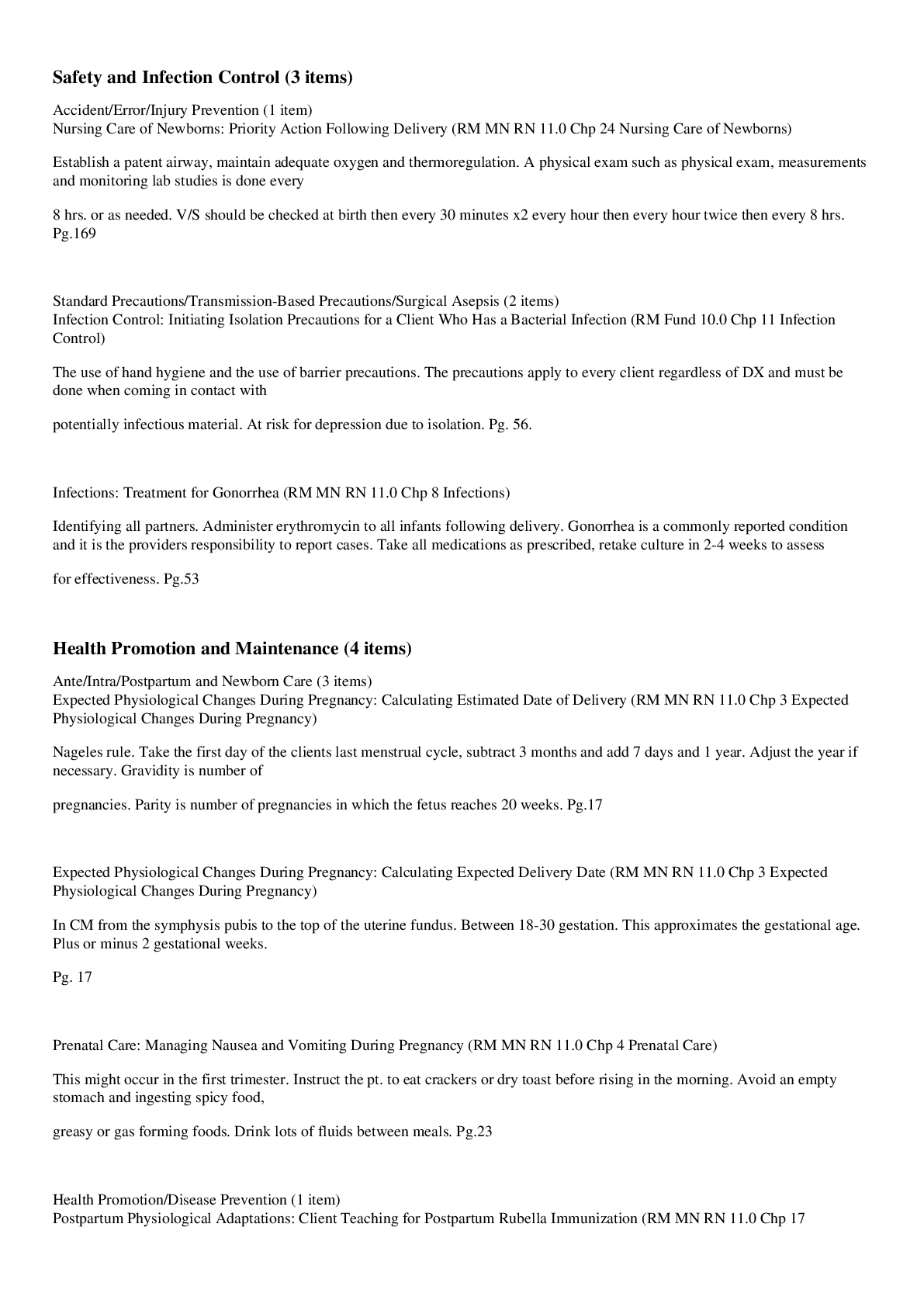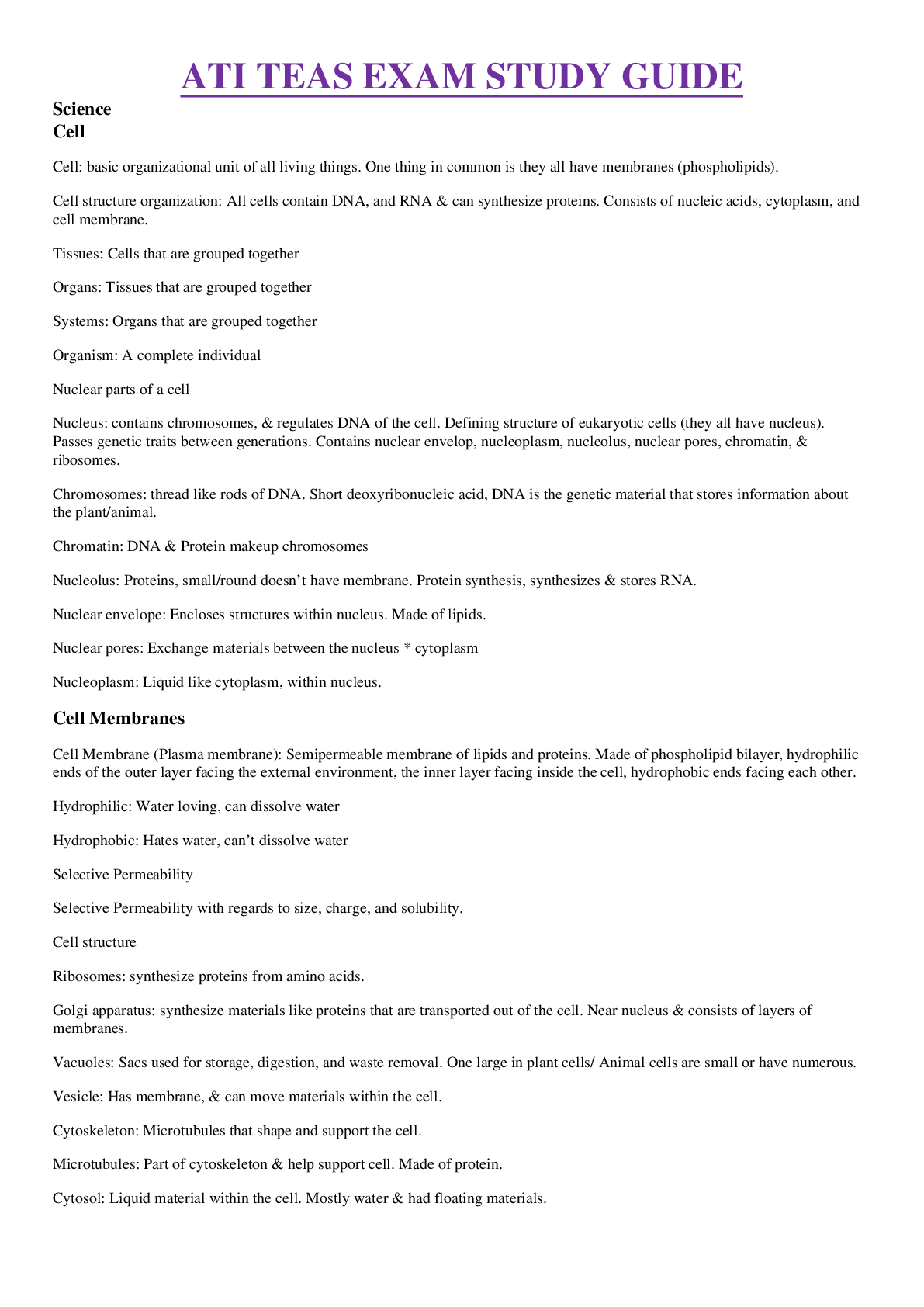*NURSING > QUESTIONS and ANSWERS > ATI TEAS 6 EXAM STUDY GUIDE (complete A+ guide) (All)
ATI TEAS 6 EXAM STUDY GUIDE (complete A+ guide)
Document Content and Description Below
ATI TEAS 6 EXAM STUDY GUIDE Science Cell Cell: basic organizational unit of all living things. One thing in common is they all have membranes (phospholipids). Cell structure organization:... All cells contain DNA, and RNA & can synthesize proteins. Consists of nucleic acids, cytoplasm, and cell membrane. o Tissues: Cells that are grouped together o Organs: Tissues that are grouped together o Systems: Organs that are grouped together o Organism: A complete individual Nuclear parts of a cell o Nucleus: contains chromosomes, & regulates DNA of the cell. Defining structure of eukaryotic cells (they all have nucleus). Passes genetic traits between generations. Contains nuclear envelop, nucleoplasm, nucleolus, nuclear pores, chromatin, & ribosomes. o Chromosomes: thread like rods of DNA. Short deoxyribonucleic acid, DNA is the genetic material that stores information about the plant/animal. o Chromatin: DNA & Protein makeup chromosomes o Nucleolus: Proteins, small/round doesn’t have membrane. Protein synthesis, synthesizes & stores RNA. o Nuclear envelope: Encloses structures within nucleus. Made of lipids. o Nuclear pores: Exchange materials between the nucleus * cytoplasm o Nucleoplasm: Liquid like cytoplasm, within nucleus. Cell Membranes Cell Membrane (Plasma membrane): Semipermeable membrane of lipids and proteins. Made of phospholipid bilayer, hydrophilic ends of the outer layer facing the external environment, the inner layer facing inside the cell, hydrophobic ends facing each other. o Hydrophilic: Water loving, can dissolve water o Hydrophobic: Hates water, can’t dissolve water Selective Permeability o Selective Permeability with regards to size, charge, and solubility. Cell structure o Ribosomes: synthesize proteins from amino acids. o Golgi apparatus: synthesize materials like proteins that are transported out of the cell. Near nucleus & consists of layers of membranes. o Vacuoles: Sacs used for storage, digestion, and waste removal. One large in plant cells/ Animal cells are small or have numerous. o Vesicle: Has membrane, & can move materials within the cell. o Cytoskeleton: Microtubules that shape and support the cell. o Microtubules: Part of cytoskeleton & help support cell. Made of protein. o Cytosol: Liquid material within the cell. Mostly water & had floating materials. o Cytoplasm: Cytosol & organelles found within the plasma membrane, not within nucleus! o Cell membrane: Barrier that keeps materials out of cell. Determines what’s allowed in and out. o Rough Endoplasmic reticulum: Ribosomes on the surface, produce & store proteins o Smooth Endoplasmic reticulum: Helps store lipids & proteins. o Mitochondrion: Generate ATP, involved in cell growth & death. Contain their own DNA aside from the one within the nucleus. Functions: Produce energy, cell signaling, cellular differentiation, cell cycle & growth regulation. Can also have aerobic respiration. Animal Cell Structure o Centrosome: Mitosis & the cell cycle occur here o Centriole: Cellular division o Lysosome: Digests proteins, lipids, and carbohydrates. Help remove undigested substances. o Cilia: Appendages that cause a cell to move & can move fluid o Flagella: Tail like structures that help the cell move. A cell usually only has one or a few flagella. Longer than cilia. Cell Cycle: Cell reproduces, growth cell, duplication of genetic material, and cell division. Cell Differentiation: Helps determine the cell type for each cell, process is controlled by genes of each cell (zygote). Following the directions of the genes, a cell builds certain proteins and other substances to set it apart as a specific type of cell. Mitosis: DNA replication & Production of new cells IPMAT=Cytokinesis o Interphase: Cell prepares to divide by replicating genetic & cytoplasmic material. (G1, S, G2) o Prophase: Chromatic thickens & nuclear membrane disintegrates. Centrioles move to opposite sides of the cells, and spindle fibers form. Mitotic spindle, formed cytoskeleton parts, moves chromosomes around the cell. o Metaphase: Spindle moves to the center of the cell. Chromosomes align in the center. o Anaphase: Sister chromosomes begin to pull apart. When separated they’re called daughter chromosomes. Grooves appear in the cell. Cell begins to furrow. o Telophase: Spindle disintegrates, nuclear membrane reform, and chromosomes turn into chromatin. In animal cells membrane is pinched, in plant cell a new cell wall begins to form. Splits into two. o Cytokinesis: Physical splitting of the cell. Meiosis: Reproduction of gametes zygote o Prophase I: Parent cell's nuclear membrane begins to disappear, spindles form o Metaphase I: Chromosomes line up with homogonous chromosomes. Crossing over may occur o Anaphase I: Homogonous chromosomes are separated, so one of each goes to either side o Telophase I: Cell separates, cytokinesis occurs o Prophase II: Almost simultaneous with Telaphase I; new spindles form and attach to centromeres o Metaphase II: Chromosomes line up again, and some crossing over may occur o Anaphase II: Sister chromatids pulled apart at centromeres, towards poles o Telophase II: Cell separates, nuclear membranes form, cytokinesis occurs o Interphase: Diploid sex cells have double the normal chromosomes necessary Tissues Categories of Tissues o Epithelial: Cells are tightly joined. Ex. Skin o Connective: May be dense, loose, or fatty. Protects and binds body parts. Ex. Bone tissue, cartilage, tendons, ligaments, fat, blood, and lymph. o Cartilage: Cushions & provides structural support for body parts. Jelly like base and fibrous. o Blood: Blood transports oxygen to cells and removes wastes. Carries hormones and defends against diseases. o Bone: Hard tissue that supports and protects softer tissues & organs. Marrow produces red blood cells. o Muscle: Helps support and move the body. 1. Smooth Cardiac Skeletal o Nervous: Located inside the brain, spinal cord, and nerves. Neurons form network through the body that control responses to changes in the external and internal environment. Some send signals to muscles and glands to trigger responses. Organs Mammals 11 organ systems 1) Integumentary system 2) Respiratory system 3) Cardiovascular system 4) Endocrine system 5) Nervous system 6) Immune system 7) Digestive system 8) Excretory system 9) Muscular system 10) Skeletal system 11)Reproductive system Three Primary Body Planes o Transverse (horizontal): Superior and inferior o Sagittal plane: Right and left sections. o Coronal (frontal): Front & Back {anterior & posterior} Terms of direction o Medial: toward or at the midline of the body; on the inner side of o Lateral: away from the midline of the body; on the outer side of o Proximal: closer to the origin of the body part or the point of attachment of a limb to the body trunk o Distal: farther from the origin of a body part or the point of attachment of a limb to the body trunk o Anterior: toward or at the front of the body; in front of o Posterior: Toward or at the back of the body; behind o Cephalad=Head, Cranial=skull o Caudad=towards the tail or posterior o Superior: toward the head end or upper part of a structure or the body; above o Inferior: away from the head end or toward the lower part of a structure or the body; below Respiratory System Upper respiratory system: Nose, nasal cavity, mouth, pharynx and larynx. Lower respiratory system: Trachea, lungs, and bronchial tree Airway: nose, nasal cavity, mouth, pharynx (throat, larynx (voice box), trachea (windpipe), bronchi, and bronchial network. o Lined with cilia, which brings debris toward the mouth o Lungs: Bronchi, Bronchial network, alveoli Alveoli: one cell thick, allow gas exchange with blood capillaries. Right lung has three lobes Left lung has two lobes, leaving room for heart. Lungs are surrounded by pleural membrane, reduces friction between surfaces when breathing. Breathing includes diaphragm & intercostal muscles. • Diaphragm: dome-shaped muscle that separate the thoracic and abdominal cavities. Functions of the Respiratory System o Function: Supply oxygen and rid the body carbon dioxide. Exchange of gases occurs in alveoli, surrounded by blood capillaries. o Filters air. Air si warmed, moistened, and filtered as it passes through the nasal cavity. o Responsible for speech, air passes through larynx (vibrates &produces sound) before entering trachea (windpipe). o Vital in cough production, expels foreign from body. o Chemoreceptors smell airborne particles in nasal cavity. o Helps body maintain acid-base homeostasis. Hyperventilation increases blood pH during acidosis (low pH), slowing breathing during alkalosis (high pH) helps lower blood pH. Breathing process o Breathing process: Diaphragm & intercostal muscles contract to expand lungs. o Inhaling: Diaphragm contracts & moves down, increasing the size of the chest cavity. o Exhaling: Intercostal muscles contract & ribs expand, increasing size & volume in the chest cavity. Pressure inside the chest cavity decreases. o Diaphragm & intercostal muscles relax, size of the chest cavity decreases, forcing air out of the lungs. o Medulla oblongata: controls breathing process Medulla monitors level of carbon dioxide in blood, & signals breathing rate to increase when levels are too high. Cardiovascular System Responsible for the internal transport of substances to and from cells. o Made up of the following Blood: Blood is composed of water, solutes, and other elements in a fluid connective tissue. Blood Vessels: Tubules of different size that transport blood. Heart: Muscular pump providing the pressure necessary to keep blood flow. o Circulatory systems can be open or close. o Supplementary & Lymph clean up excess fluids & proteins & returns them to the circulatory system. o Blood: Stabilizes pH, carries raw materials & removes waste products from cells. Can fight infections. Composed of red & white blood cells, platelets & plasma. • Plasma composed of plasma proteins, ions, glucose, amino acids, hormones, & dissolved gases. o Red blood cells form in bone marrow, and transport oxygen to cells. o White blood cells defend the body against infection and remove various wastes. White blood cells include lymphocytes, neutrophils, monocytes, eosinophils, & basophils. Platelets are fragments of the stem cell & function in blood clotting. Heart o Made of cardiac muscle tissue. o Four chambers two atriums & two ventricles Halves separated by AV valves • Located between arteries & ventricles leading away from the heart. • Valves move blood in one direction, preventing it from backing into the chambers. • Heart functions by contracting & relaxing • Cardiac Cycle: Atrial contraction fills the ventricle & ventricular contraction empties them, forcing circulation. >>>>>>>>>>>>>>>>>>>>>>>>>>>>>Continued [Show More]
Last updated: 2 years ago
Preview 1 out of 27 pages

Buy this document to get the full access instantly
Instant Download Access after purchase
Buy NowInstant download
We Accept:

Reviews( 0 )
$15.00
Can't find what you want? Try our AI powered Search
Document information
Connected school, study & course
About the document
Uploaded On
Feb 23, 2021
Number of pages
27
Written in
Additional information
This document has been written for:
Uploaded
Feb 23, 2021
Downloads
0
Views
139



.png)











